INTRODUCTION TO WESTLAKE

- Pendersleigh & Sons Cartography's oil paint map of Westlake
Los Angeles's Westlake neighborhood is home to more people than the entire populations of well-known California cities like Berkeley, Inglewood, Burbank, Compton, Santa Monica, and Santa Barbara. In fact, the neighborhood and Pico-Union are together home to the largest population of Central Americans in the entire US. After Koreatown, Westlake is the second most-densely populated neighborhood within the most-densely populated urban area in the country. Given these distinctions, it's somewhat surprising the more people don't talk or write about the neighborhood. Most observations about Westlake that I've heard are limited to disparagements of its grime, crime, and criminalized. I've known people who live there to stretch boundaries to that they can refer to it as Koreatown (if they're west of Alvarado) or Downtown if they're east. Representing Westlake seems to be almost unheard of, which is a shame, because it actually has quite a lot going for it.
The problem is, as I see it, that most Angelenos and visitors see Westlake from within their cars and from behind the wheel it can be harrowing to drive through a densely-populated, bustling community. When I first visited Los Angeles, the Koreatown skyline was the first place that caught my eye yet my hosts attempted to steer me away, toward a memorial sidewalk in Hollywood -- or somewhere someone once saw Keanu Reeves having lunch -- in other words, places that I had no interest in going. I thus took a daytrip to Koreatown and found it much more interesting. Westlake is another place which fascinates once one gets out of their car. I can't imagine why anyone would drive if walking is an option and Walkscore gives Westlake a walkscore of 86 (out of 100). It assigns the neighborhood a transit score of 80, although I can't really imagine a place with more transit coverage. You could always be sensible and get a bike -- if you're in the neighborhood at Felipe's. Anyway, the best way to see Westlake is on foot and not long ago Lynn from Hidden Los Angeles and I decided to explore it thus.
*****
EARLY HISTORY OF THE AREA
What's now Central Los Angeles (the Downtown, Hollywood, Midtown, and Mideast Side districts) was settled by the ancestors of the Chumash at least 13,000 years ago. The Tongva (or Kizh) arrived in the area around 3,000 years ago, having apparently begun their journey to the east in the Sonoran Desert. The area around what's now Westlake was then a low depression surrounded by hills and centered around a soda lake fed by seasonal rains and streams.
Explorer Juan Rodríguez Cabrillo claimed California for the Spanish Empire in 1542 but it wasn't until Gaspar de Portolà led an overland expedition through the area in 1769 that the Spanish Conquest really got into full swing. The first Spanish mission was built in the Whittier Narrows in 1771 before being relocated to San Gabriel. Ten years later, El Pueblo de Nuestra Señora la Reina de los Ángeles del Río de Porciúncula was founded a bit west. The pueblo was granted four square leagues of land, the western edge of which corresponds to what's now Hoover Street. New Spain achieved its independence from the empire in 1821 and as a result, all of Southern California became part of Mexico.
Despite being the capital of Mexican province, Alta California, Los Angeles remained a small pueblo whilst it was Mexican. That era ended in 1848 after Mexico was defeated by the US in the Mexican–American War. In 1850 California became a state and Los Angeles was incorporated but remained a very small town for another quarter century. In 1876, Los Angeles was connected to the rest of the world by the arrival of the Southern Pacific Railroad. The Atchison, Topeka, and Santa Fe Railroad ended SP's rail monopoly when it arrived in 1885 and set off a rate war between the two rivals which spurred a massive population explosion in 1887.
WESTLAKE PARK (MACARTHUR PARK)

- "West Lake Park" (1891 - image source: Photo Collection, Los Angeles Public Library)
I've heard many people claim that no one refers to Westlake as such, because Westlake Park is now known as MacArthur Park. Personally, I suspect if handed a map and marker, few would draw the MacArthur Park neighborhood's boundaries around all of what is generally thought of as Westlake. In Westlake, there are separate neighborhood councils for MacArthur Park, Westlake North, Westlake South, and charming Rampart Village. Still, MacArthur Park has always been the community's centerpiece and even in its current degraded state, understandably so.
Los Angeles bought the land to build Westlake Park in 1886 after previously using the marshy wetlands as a garbage dump. In 1881, over in Lincoln Heights (then known as East Los Angeles), East Los Angeles Park had been built with a similar design on land similarly deemed suitable for little else. In 1901, East Los Angeles Park was re-named Eastlake Park and it and Westlake Park served as the primary garden spots of the city's Eastside and (old) Westside, respectively. In 1890, Westlake Park's lake was enlarged and in 1896 a bandshell was erected that still stands. It was restored in 2007 and now a series of free summer concerts known as Levitt Pavilion MacArthur Park annually take place. Performers in 2014 included Metalachi, Ozomatli, Quetzal, Richard Thompson, and Very Be Careful, among others.
East Los Angeles was renamed Lincoln Heights (East Los Angeles "moved" to its current location around the 1930s) and Eastlake Park thus became Lincoln Park. Westlake Park retained its directional affiliation for several decades -- even as the westside moved westward to the Pacific -- until 1942, when it was renamed MacArthur Park after Douglas MacArthur.
When I moved to Los Angeles in the 1999, I regarded MacArthur Park almost like I used to Skid Row -- as a sort of open air drug market and homeless encampment. When I visited the park it was never because I wished to relax on the banks of its great grey-green, greasy waters nor because I longed to inhale their fetid aroma. Neither was it because I wanted to buy a counterfeit ID or green card, even though walking along crowded Alvarado Street I was always offered them. I usually visited MacArthur Park because it has long been a popular site -- for whatever reason -- for political protest.
In 2005, cameras were installed within the park and crime reportedly decreased -- or at least moved out of their sight. That doesn't mean that one should get drunk and pass out in the park, as someone once confided in me that she'd done; this is America, after all, and even in the safest urban settings bad things happen more often than you’d like. If you don't want to be eaten by sharks, don't dump chum in the water. Westlake actually has a lower violent crime rate than West Hollywood -- although it should also be noted that working class immigrants tend not to report crimes as often as those who have less reason to fear the police (and West Hollywood actually has a fairly high violent crime rate).
Both MacArthur Park and it’s sister, Lincoln Park, would both benefit greatly from the sort of rehabilitation that was granted to Echo Park Lake but sadly, that probably won’t happen until yuppies move in and the working class that live there now are priced and pushed out. Walking in Westlake now that demographic shift seems a long ways off but developers have had their magpie eyes on the mini-metropolis tantalizingly situated between the nuclei of Koreatown and Downtown for decades, and they’re just waiting to make their move. The new yuppies, increasingly rejecting car-dependency and dreary suburbs for urban bustle, might come sooner than later.
There are other parks in Westlake too, including Lafayette Park (opened in 1899 and where our exploration began), Hope and Peace Park, and Beverly Park, although the identity of the latter is more aligned with Filipinotown to the north, which was prior to official recognition thought of as Westlake (or Echo Park or Silver Lake — depending on who you ask).
There's at least one pocket park, Valencia Triangle, which has on it a bust of Francisco Morazán -- president of the Federal Republic of Central America.
EARLY WESTLAKE – THE INDUSTRIAL ERA

- Detail of JR Prince's Territory Annexed to the City of Los Angeles, California, 1781-1916 (image source: Big Maps Blog)
For 115 years, the Mideast Side including Westlake was the city’s Westside. Finally, in 1896, the great West Coast city, Los Angeles, actually started spreading west toward the coast. The first western annexation moved the city’s western edge to what’s now Arlington Avenue. Dispatching with Spain's leyes de Indias, the American Los Angeles was reoriented along the cardinal directions, as prescribed by Thomas Jefferson, and not along the Los Angeles River. That’s why when you go west of Hoover into Wilshire Center, all of the streets shift their orientation.
Few of the homes in Westlake were built before 1890, when the Los Angeles City Oil Field was first tapped, launching an industrial boom. Today there is just one active oil well on that field and it’s located near the intersection of South Mountain View Avenue and Miramar Street in Westlake.
EDWARD A. STRONG RESIDENCE
There is at least one Westlake home built in the 1880s, the Edward A. Strong Residence, which was completed in 1887. However, it was located nearby in Downtown and was only moved to Westlake in 1989, when it proved to be in the way of the expanding Los Angeles Convention Center. After its move, the mansion (located at 826 S. Coronado Street) was converted into six low-income units by architects, Tom Micahli and Barry Milofsky, who were awarded a preservation award for their efforts in 1992.
SAMUEL J. LEWIS HOUSE
The oldest surviving home native to the neighborhood is probably the Queen Anne style Samuel J. Lewis House was built around 1890 at 1425 Miramar Street. It is believed to have been designed by Joseph Cather Newsom.
CHARLES B. BOOTH RESIDENCE
The Charles B. Booth Residence and Carriage House were built around 1893 at 824-826 S. Bonnie Brae Street. Their mix of Colonial Revival and Moorish styles was concocted by architect James H. Bradbeer.
THE WRIGHT-MOOERS HOUSE (aka the FREDERICK MITCHELL MOOERS HOUSE)

- Wright-Mooers House (image source: Michael Locke)
The Victorian style Wright-Mooers House was built in 1894 at 818 S. Bonnie Brae Street. Its original owners were Gertrude and FL Wright. In 1898 the couple sold the property to Frederick Mitchell Mooers who, following years of fruitless prospecting, had struck it rich with the discovery the Yellow Aster gold mine in 1895 and decided to buy himself a mansion in Westlake.
SUSANA MACHADO BERNARD HOUSE AND BARN
The Gothic revival Susana Machado Bernard House at 845 S. Lake Street was completed in 1902. It was designed by noted architect John B. Parkinson, who designed many civic, commercial, and financial institutions in old Downtown but far less-often worked with residential structures. In 1996 the home was purchased by the Center for Human Rights & Constitutional Law who since 2002 have used it as a shelter for formerly homeless minors. It’s now known as Casa Libre.
CHARLES C.L. LESLIE RESIDENCE

- Charles C. L. Leslie Residence (image source: Michael Locke)
The Queen Anne style Charles C. L. Leslie Residence, at 757-767 Garland Avenue, was designed by architects Oliver P. Dennis and Lyman Farwell and was completed around 1903. It was apparently first used as the residence of Dennis, who designed the Magic Castle in Hollywood. Its name is derived from that of a later resident who was an oil industry executive and who lived there at least by the 1920s.
FRANK C. HILL HOUSE

- Frank C. Hill House (image source: Michael Locke)
The Craftsman style Frank C. Hill House at 301 S. Coronado Street was built in 1910 and designed by Albert R. Walker and John C. Vawter. It was designated Los Angeles Historic-Cultural Monument No. 980 in 2010.
GOOD SAMARITAN HOSPITAL
Good Samaritan Hospital was established in 1885 but to what was then Orange Street (now Wilshire Boulevard) in 1911. Major expansions and construction occurred in the 1920s, '30s, and '50s. In 1968, after being shot down the street at the Ambassador Hotel, Senator Robert F. Kennedy of New York died in Good Sam. Another expansion began in 2011 and is scheduled to be completed in 2015.
MARY ANDREWS CLARK MEMORIAL HOME
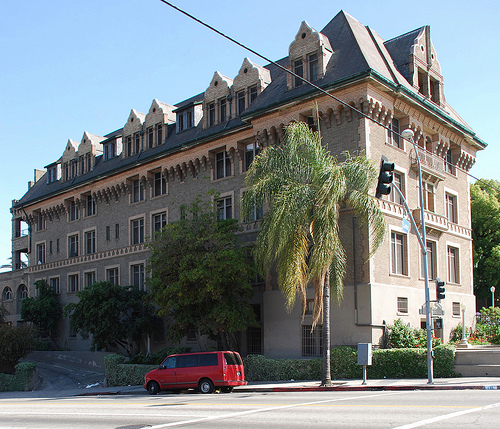
- Mary Andrews Clark Residence (image source: Big Orange Landmarks)
The French Revival Chateauesque style Mary Andrews Clark Memorial Home at 306 Loma Drive was built by copper magnate William A. Clark (who named it after his mother). From its opening in 1913 until 1987 it operated as a YWCA. It was closed after sustaining damage in the Whittier Narrows Earthquake and finally reopened, as low income housing, in 1995.
HIGHRISE ERA — DENSIFICATION
The first high-rise built in Westlake was the Bryson Apartment Hotel, built in 1913, but the urbanization of Westlake really took off in the 1920s, aided in large part by a Jewish population who’d previously been ghettoized in by-then aging neighborhoods of Brooklyn Heights and Boyle Heights. Around the 1920s they began their exodus to Hollywood, Midtown, and the Westside but many first stopped in Westlake and the neighborhood was in part because of the demographic occasionally compared to Manhattan's Upper East Side.
BRYSON APARTMENT HOTEL

- Bryson Apartments (image source: Office of Historic Resources)
The Beaux Arts style Bryson Apartment Hotel at 2701 Wilshire Boulevard was completed for developer Hugh W. Bryson in 1913. Being the first high-rise in the neighborhood helped establish it as a symbol of urbanization. It was featured as a setting in Raymond Chandler's 1943 novel, Lady in the Lake, and was seen in the noir (and neo-noir) films Double Indemnity (1943) and The Grifters (1990) (as well as the perhaps less-norish Barfly (1987) and Magnolia (1999)).
PACIFIC DINING CAR

- Pacific Dining Car (image source: Rebecca Pardess)
One of the most-celebrated restaurants in Los Angeles, the Pacific Dining Car, opened in Westlake in 1921. Despite my love of trains (it was built to resemble a train car but not actually converted from one) and it being open 24 hours/365 days a year, in fifteen years I still haven't made time to visit it -- perhaps because a part of me feels like there's no rush. It was seen in the films Training Day (2001), Street Kings (2008), and Rampart (2011).
COMMODORE REGENCY APARTMENTS
The thirteen story Commodore, at 685 S. Lucas Ave, was built in 1922.
AFL LOCAL 69
The AFL Local 69, located at 846 S. Union Avenue was completed in 1924. I don’t know anything more about it either, but its architecture caught my eye. It now seems to be home to Lighthouse Mission Church.
LOS ANGELES NURSES' CLUB
The Los Angeles Nurses' Club, at 245 Lucas Avenue, was constructed in 1924 for the non-profit founded in 1921. It was, according to the Los Angeles Times in 1923, designed to provide a place “where registered nurses may live and enjoy the few quiet hours spared from their arduous duties.” The architect on the project was John J. Frauenfelder and it was the first clubhouse in the US to be entirely financed and built by and for nurses.
PARK WILSHIRE APARTMENTS
Park Wilshire Apartments, at 2424 Wilshire Boulevard, were built in 1924.
YOUNG'S MARKET BUILDING
Young's Market Building, at 1602 West 7th Street, opened in 1924 as a the central market, distribution center, and headquarters of the once mighty Young's Market grocery store chain. It’s Spanish Renaissance Revival style was designed by Charles F. Plummer. By the time of the 1992 riots, it was home to the Andrew Hardware and Metal Company and suffered from looting. In 1997 it was converted into live-work lofts and a Michael's but currently it seems to be undergoing yet another conversion. Behind the scaffolding and construction equipment one can still make out the marble columns and terra cotta frieze that help make it worth preserving.
THE ASBURY
The thirteen-story Asbury, at 2050 West 6th Street, was completed in 1925. It's seen in the 2011 video game, L.A. Noire.
THE GLEN DONALD BUILDING
The Glen Donald Building was built in 1925 and was originally an hotel. In 2010, the skeletons of two infants were discovered in a trunk in the basement. Detectives later determined that the trunks which contained the infants' remains had belonged to Janet Mann Barrie, a Scottish-born private nurse for George and Mary Knapp. Mary Knapp died in 1964 and George married his nurse. George died in 1968 and Nurse Barrie in 1992. The identity of the babies, as far as I know, has yet to be determined.
PARK PLAZA HOTEL
The twelve-story neo-Gothic and Art Deco Park Plaza Hotel, at 607 S. Park View Street, was completed in 1925 and built to be used as an Elks Lodge. It's easily one of the most stunning buildings in the city and looks to me like it was designed by the chief architect of Gotham City. It is in fact a creation of Claud W. Beelman's firm, Curlett & Beelman. It was also featured in several films including Less Than Zero (1987), The Bodyguard (1992), Buffy the Vampire Slayer (1992), and Drive (2011).
PRECIOUS BLOOD CATHOLIC CHURCH
The Italian Romanesque Precious Blood Catholic Church, at 435 S. Occidental, was built in 1926. The original parish, founded in 1923, was mostly comprised of Irish and Italian-Americans. By the 1970s, following a shift in the neighborhood's demographics, most of the churchgoers were Mexican-Americans. By the 1980s, yet another demographic shift had taken place the congregation has ever since been mostly comprised of Filipinos. When we attempted to pop Lynn and I were greeted by a couple of ladies who told us that they couldn't access the sanctuary and kindly told us to come back and check out the church during service.
THE MASQUE THEATRE (now HAYWORTH)

- The Vagabond (image source: Cinema Treasures)
The Churriqueresque Hayworth Theatre opened as the The Masque Theatre, a playhouse, in 1926. It was designed by the architectural firm Morgan, Walls & Clements. In 1950 it was renovated and re-opened as a repertory movie theater, The Vagabond, which was seen in the film The Naked Gun (1988) but stopped showing films in 1993. Like so many former movie theaters, The Masque was born again as a church. The theater side once again became a playhouse, The Hayworth Theatre, in 2006, when the Circus Theatricals Theatre Company moved in. The building was also home to La Fonda Restaurant Building, a popular Mexican restaurant, from 1968 until early 2014.
WESTLAKE THEATRE
Even more grand than The Masque was The Westlake Theatre, a 1,949-seat silent picture palace and vaudeville stage designed by Richard D. Bates, Jr and completed in 1926. It was renovated in 1935 by the great, prolific theater architect, S. Charles Lee. One of my favorite silent comedians, the underrated Harry Langdon, was caught there by his wife whilst on a date with another woman in 1927 (whom he’d naturally taken to see his latest film).

- Westlake Theatre (image source: Cinema Treasures)
1927 didn’t just spell the end of Langdon’s marriage but, for the most part, silent film. The theater soon switched to talkies but by the 1960s, reflecting the demographic change of the neighborhood, those talkies were in Spanish. In 1973, Jim Jones, the founder and the leader of the Peoples Temple (who had a temple nearby in Pico-Union), exposed and pleasured himself for the benefit of an undercover police officer. Jones' urologist sent the LAPD a doctor's note explaining that wanking was something Jones had to do before urinating because of a strange condition from which he suffered and charges were dropped. Of course this relatively minor transgression pales in comparison to his most infamous -- commanding the murder and mass suicide of nearly 1,000 people in 1978. In 1991 the Westlake was converted into a swap meet. In 2008 the the now defunct CRA purchased it with plans for its renovation since the CRA is no more, it currently sits empty behind behind the veritable sidewalk sale that occupies that stretch of Alvarado.
THE CRESCENT ARMS
THE CRESCENT ARMS
The Crescent Arms, at 1709 West 8th Street, opened in 1926. It's currently used as senior housing.
THE GRANADA BUILDINGS
Granada Buildings, located at 672 S. Lafayette Park, were built in 1927. The charming complex of Mediterranean and Spanish Colonial Revival buildingd was an early mixed-user designed by architect Franklin Harper. The 42 offices were topped by residences – something which at the time was viewed as a new concept — in Los Angeles. The charm of the structure not surprisingly was a draw for creative types and architects Gregory Ain and James Garrott as well as photographer George Hurrell all maintained offices and residences there.
IMMACULATE CONCEPTION CATHOLIC CHURCH
Immaculate Conception Catholic Church, at 1433 James M. Wood Boulevard, was built in 1928.
THE PARK METRO WILSHIRE
The thirteen-story Park Metro Wilshire, at 1930 Wilshire Boulevard, opened in 1928. Today it's also known as the Wilshire Medical Building.
WILSHIRE ROYALE APARTMENTS
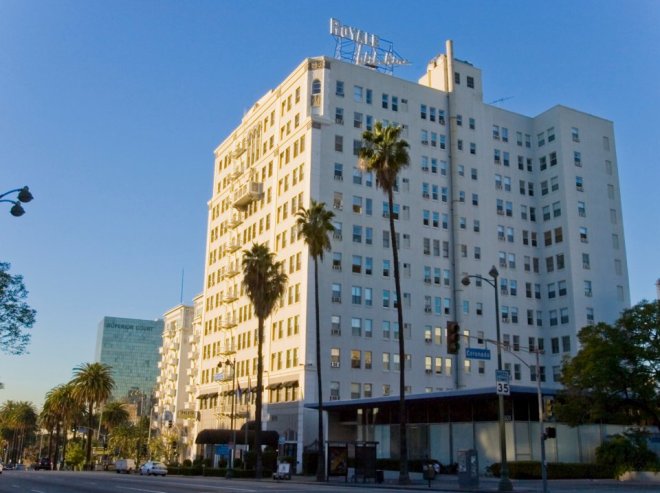
- Wilshire Royale Apartments (image source: Wilshire Royale Apartments)
The Wilshire Royale Apartments, at 2619 Wilshire Boulevard, were built in 1929. There used to be a weekly bar night they hosted called, with considerable geographic license “Eastside Mondays.” Despite the borderline offensiveness of the name, it was a popular spot for the notorious party crew known as Rock & Roll Mondays.
THE EXTENSION OF WILSHIRE BOULEVARD
There are boulevards and streets in Los Angeles, the names of which are familiar around the world: Abbot Kinney, Sunset, Hollywood, Rodeo, Santa Monica, Melrose, Mulholland, and Ventura, to name but a few. Despite not being as well known outside of Los Angeles, most Angelenos would surely identify Wilshire Boulevard as our city's true Main Street.
In the 1930s, the exodus away from Downtown moved west down Wilshire, which by-then extended from the Pacific Ocean to the western edge of Westlake Park. On the other side of the park, connecting to Downtown, was a relatively minor street, Orange. Hoping to tap into Wilshire's momentum, the buildings along Orange were demolished and the street was widened and made part of Wilshire, although interrupted by Westlake Park. The two sections of Wilshire were planned to be joined by tunnel under the park but the Great Depression convinced the city to go with a cheaper option, bisecting the park with a causeway.
Westlake was disfigured as a result, but at least the scar allowed for uninterrupted traffic from Downtown to the new Westside, which had by reached the Pacific Coast. That uninterrupted traffic was by design, car-oriented, and whereas every other main east-west street through Westlake was shared by cars and the yellow cars of the Los Angeles Railway, Gaylord Wilshire, (though he’d died in 1927) had donated his namesake boulevard to the city on the condition that commercial and industrial trucks as well as all rail be banned from it for all time. A deal's a deal and nearly 90 years later, rather than change the law, Metro are hard at work slowly extending a subway under Wilshire, slowed to a glacial pace by the subterranean and noxious cocktail of methane, NIMBYS, and politicians. Optimistically nicknamed the “Subway to the Sea,” the subway might just make it to the shores of the Pacific several decades from now — if the ocean's waters don’t rise to meet it first.
LANGER'S DELICATESSEN
Canter Brother's Delicatessen had opened in Brooklyn Heights in 1931 but moved, with much of that neighborhood's Jewish population, to the Farifax District in 1941. The city's other great Jewish deli (according to animal-eaters) is Langer's, which opened at 704 S. Alvarado Street. Although I don’t know what exactly pastrami is, none other than The New Yorker proclaimed that the hot pastrami sandwich served at Langer’s is the best in the country and that made some people in New York mad, apparently. For the record, after eating hers, Una said that she'd had better in Montreal which -- of course -- is in another country. During our exploration, we popped in for lunch, to get out of the sun, and to rest our legs (and for me charge my phone). There were of course (this being 2014) vegetarian options (including almost ice-cold macrobrews) and the ambiance was pretty amazing.
WESTLAKE IN THE ERA OF WHITE FLIGHT
Following the end of World War II in 1945, Southern California famously saw an explosion of overnight, instant suburbs built at its formerly agricultural fringes. That they were incredibly remote and lacked access to both low and high cultural opportunities was not important because a comprehensive freeway plan was produced in 1947 and the suburb’s new residents could use them to zip back and forth not just to work but all corners of the Southland — in under 20 minutes!
Although the US Supreme Court banned the enforcement of racist housing codes in 1948, suburban bans on multi-family residences (like apartments) meant that the suburbs would initially be reserved for the mostly white and largely middle class. At the same time, those on the Right argued that providing public housing for World War II veterans and the poor amounted to Soviet style communism and thus the construction of new housing projects ceased after 1955. Making matters worse, working class downtown neighborhoods like Bunker Hill and Dogtown were demolished in the name of urban renewal and torn through to make way for the freeways.
Many Filipinos relocate from the old Little Manila (which was located just west of Little Tokyo) into the what’s now Filipinotown, where homes were opening up as white Angelenos were moving out. With public housing killed and poor neighborhoods destroyed completely, affordable housing was in short supply and slumlords came to happily establish a profitable monopoly over bottom-end housing.
Many Filipinos relocate from the old Little Manila (which was located just west of Little Tokyo) into the what’s now Filipinotown, where homes were opening up as white Angelenos were moving out. With public housing killed and poor neighborhoods destroyed completely, affordable housing was in short supply and slumlords came to happily establish a profitable monopoly over bottom-end housing.
Most of the new developments of the era were commercial, not residential, and located at Westlake’s eastern edge. They included the eighteen story Pacific Telephone Company Building in 1954 (and since renamed 1010 Wilshire and turned into luxury apartments) and the Unocal Building in 1958 (at 1201 West 5th Street and now Los Angeles Center Studios.
At the time of the Unocal Building's completion, it was actually taller than any building downtown although developers wouldn’t start attempting to rebrand the area as Center City West for a couple more decades.
At the time of the Unocal Building's completion, it was actually taller than any building downtown although developers wouldn’t start attempting to rebrand the area as Center City West for a couple more decades.
AMERICAN CEMENT BUILDING

- American Cement Building (image source: Larry Underhill for Los Angeles Conservancy)
There were a couple of significant construction projects during the 1960s - my favorite being the American Cement Building (now the Cement Building Lofts), which was constructed at 2404 Wilshire Boulevard in 1964 as a headquarters for the company and as a showcase of the architectural and construction possibilities of concrete.
1127 WILSHIRE CENTER
1127 Wilshire Center was completed in 1968.
GLF HQ
One of the less physically imposing arrivals of the 1960s was the Gay Liberation Front's Morris Kight, who bought a home at 2230 W. 6th Street in which the loosely-structured GLF were headquartered from 1969-1972. The GLF famously formed in New York after the Stonewall Riots. In West Hollywood, the GLF raised their local profile when they protested Barney’s Beanery for it’s long-present sign stating “Fagots – Stay Out” [sic].
WESTLAKE’S DECLINE
During the 1970s, yet another demographic shift began to occur. Distant suburbs were no longer white only and now mostly-Asian Hacienda Heights in the San Gabriel Valley was marketed (along with other communities) as the “Chicano Beverly Hills.” By the end of the decade, a new stream of immigrants were arriving, refugees from Central America. For those truly dispossessed by brutal civil war, a cramped space in a run-down tenement or subdivided an neglected mansion terrorized by gangs (both criminal and police) was still preferable to the death squads back home.
In 1970 a fire at Downtown's run-down Ponet Square Apartment-Hotel had killed nineteen people. Sadly it wasn't a surprise as it had been condemned in 1941 and in 1945 a writer for the Los Angeles Herald had written about it specifically, stating:
If a fire occurs, the place will become a holocaust. It is unfortunate that a city such as Los Angeles does not have stricter building codes; and that the owners of dilapidated structures are permitted to keep them in operation.
Less than a year earlier, in 1969, another run-down slum had caught fire and killed nine people in Westlake. In 1971 the city enacted the Ponet Square Ordinance, which simply applied its 1943 fire safety codes to all buildings built before that date but there was little enforcement; an audit found that only one in three buildings was even subjected to annual safety inspection.
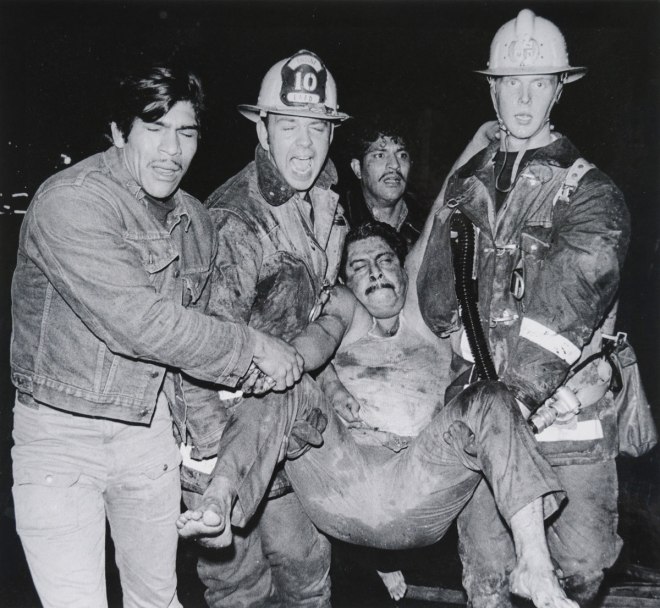
- Fire Rescue (image source: Joe Messinger)
In 1973, a fire in the Stratford Apartments started in the lobby and 25 people were killed and 52 injured – many jumping from their windows after discovering that there were no longer functioning fire escapes. To this day it is the deadliest fire in Los Angeles history. In 1976, another fire erupted in another building, this time on Witmer, and ten more people were killed. On one floor responding firefighters found 75 peopling crammed into nine single-room units sharing a single bathroom.
Cramped conditions, of course, meant that the fires were deadlier than they otherwise would have been but with no new public housing being constructed, absentee slumlords maintained their profitable stranglehold over the poorest of the poor who had little choice but to cram themselves into crumbling tenements. Another audit after the latest deadly fire found that only six percent of slumlords were in compliance with the Ponet Square Ordinance.
The then-owner of the Stratford Hotel – when given the option of prison or living in his own building whilst it was brought up to code – chose the former. The Stratford Hotel (which is not the same as the Stratford Apartments -- which burned to the ground) was formerly home to one of my frequent California Fool's Gold traveling companions, Tim Shimbles, and although it's no longer the postcard-perfect luxury hotel it apparently was in the 1930s, it's currently owned by different owners and more resembles a rather worn-out Korean retirement home than the slum it apparently once was.
THE FALL AND RISE OF LITTLE CENTRAL AMERICA
During the Cold War, using the excuse of anti-communism, the US fought to maintain a profitable post-colonial presence in Central America. Guatemala's recent history of US meddling goes back at least to Eisenhower's presidency, when the CIA removed that country's democratically-elected leader and installed the first of several hand-picked right wing dictators in 1954.
In 1980, the Carter administration and Israel began funding the right wing paramilitary forces of El Salvador during that country's long civil war. In 1985, the Reagan administration began secretly selling weapons to Iran (then at war with the also-US-supported Iraq) and funneled the profits to anti-communist death squads in Nicaragua. The obscene violence that engulfed Central America resulted in an mass exodus of refugees to the US which transformed Westlake and Pico-Union into the largest concentration of Central Americans in the country which it remains today. At 2.3 million, Salvadorans now make up the second largest group of Latinos in the US and four in ten live in California.
THE RISE OF CITY WEST
Without doing much to fix Westlake, civic leaders and developers began promoting the name “City West” or “Central City West” to at least change perceptions of it and attract development on the other side of the 110 Freeway. With the 110 apparently standing in for the Seine, some even promoted referring to Westlake's eastern edge as "Downtown’s Left Bank” although it more often was referred to as “Downtown’s New Jersey.”
LOYOLA LAW SCHOOL

- Loyola Law School (image source: Hollywood Locations)
One of the first significant architectural projects of the 1980s was Loyola Law School, the campus of which had been designed by a then little-known architect named Frank Gehry, then yet to find his wadded tin-foil voice that made him such a massively popular architect.
BEAUDRY CENTER
The 29-story Beaudry Center was completed at 333 S. Beaudry Avenue in 1986. During its construction it was awarded by a group of architects, developers, and realtors, a mocking “lemon” award and was described as an “economic and architectural failure.”
1055 WILSHIRE
The 18-story 1055 Wilshire seems, like many skyscrapers of the era, to actually aspire to anonymity with both its appearance and unmemorable name.
ROLLS ROYCE OFFICE TOWER (now 1100 WILSHIRE)
The most notorious (and my favorite) of the 1980s skyscrapers was Rolls Royce Office Tower. Like its automotive namesake, it was big, shiny, hugely expensive, and utterly ridiculous looking. Between the commercial ground floor and upper nineteen stories of office space is a ridiculous, fifteen story, shiny granite parking garage. For the almost twenty years after completion the building existed in a nearly complete state of vacancy (occupancy peaked at 10%). Then, in 2005, it was converted into a 228 unit residential structure. While the parking structure remains unchained (maybe they can be converted into gardens, open air artist lofts, or a multi-story swap meet) and the building's exterior is not exactly stunning, as the second tallest residential structure in the city the views it affords probably are.
ARCO TOWER (now 1055 WEST SEVENTH)
The final noteworthy Westlake skyscraper of the 1980s was 33-story ARCO Tower, completed in 1989. In the 1990s, after suffering serious financial problems, ARCO moved out and the building is now known simply as 1055 West Seventh.
GRANDE MALL
I've always imagined Grande Mall, a mixed-user built in 1990, to be sort of like a miniature version of the old Kowloon Walled City. It's busy, gritty, cluttered, and I've seen security guards engaged in illegal activities practically in plain sight. It could all be in my head but something about that place makes my spider-sense tingle.
THE RAMPART SCANDAL
If the 1980s in Westlake were bad, the 1990s might’ve actually been worse in some respects. As if slumlords, neglect, and gangs weren’t bad enough, making matters worse was the LAPD's Westlake-based Community Resources Against Street Hoodlums (aka C*R*A*S*H) — an anti-criminal gang unit that looked for all the world like a criminal gang. A scandal was uncovered in which more than C*R*A*S*H officers were implicated in all kinds of misconduct including planting of false evidence, framing of suspects, perjury, unprovoked beatings, unprovoked shootings, theft, drug dealing, bank robbery, murder and rape (as well as cover up of evidence of those crimes). In fact, the C*R*A*S*H gang awarded one another special cards for misbehavior.
Some of the C*R*A*S*H members also worked as security for Death Row Records in their off-duty time and there was talk of possible involvement on the part of LAPD with the unsolved murder of rapper Notorious BIG, which occurred on Wilshire Boulevard over in the Miracle Mile.
Eventually the Rampart scandal blew up but when the dust settled, only five officers were fired, only seven were forced to resign or retire, and only twelve were given suspensions. On the civilian end, on the other hand, 106 criminal convictions were overturned and more than 140 lawsuits were filed against the city. As a result, $125 million dollars in settlement money was paid in what included the largest settlement in Los Angeles history -- $15 million awarded to Javier Ovando in 2000.
[youtube https://www.youtube.com/watch?v=vpte72HaLRE]
The scandal and surrounding culture of misconduct inspired the films Cellular, Crash, and Direct Action (all 2004), and Rampart (2011); the television series The Shield; and a video game, Grand Theft Auto: San Andreas (2004).
*****
WESTLAKE TODAY
Although the population of Westlake isn't often characterized as being especially diverse, this has more to do with our the manner in which diversity is typically measured. There are, after all, sizable populations of Chujes, Quichés, Q'anjob'als, and Zapotecs but because all of those nations are historically located of what’s now called the Rio Grande, they’re not counted by the census as Native Americans — which according to the census only comprise 2% of Westlake’s population. Meanwhile 29% of Westlake residents self-identify exclusively as white (69% identify as being Latino of any race). About 20% of Westlake’s residents identify as being Asian or Pacific Islander (mostly Korean or Filipino), and only 5% identify as black. The Westlake population is also 68% foreign born so it's also, in at least one since, a rather cosmopolitan place.
The densely populated neighborhood has long been in need of better housing but for whatever reason, in Westlake, most of those new homes are being built within choking distance of the 110 by Geoff Palmer. Near the former site of the Dome Village there’s a rash-like cluster of faux-Italian/faux-mixed use (the commercial levels seem always to be empty) buildings that look Israeli settlements designed by someone raised in an outlet mall. A disturbing hallmark of Palmer’s buildings are their anti-human touches: death row gangways allow the buildings’ black-lunged and brake-dust-fed tenants to avoid interacting at street level, window-ledge spike strips urge the weary to move along, and worst of all, signage written in Papyrus.
Not all housing in Westlake is sub-standard -- I’ve actually been inside some rather nice apartments in the Nob Hill Tract of Rampart Village neighborhood and there are many more beautiful Victorians and Craftsman homes, and converted hotels than are covered here -- but almost as big of a draw for me is the dining scene, which leans heavily toward Salvadoran and various Mexican cuisines.
WESTLAKE EATS
Salvadoran restaurants have only existed in Los Angeles since the 1960s. Back in 1969 and south of the 10, El Migueleno opened and still operates today. Somehow, despite having a Salvadoran uncle, I didn’t discover the cuisine until I moved to Los Angeles. Back then even Echo Park and Silver Lake had several: Los Cobanos, Nueva Rincon, and Cafe La Paz to name a few. Now there's just Maya's Tacos Market, which also serves Mexican food -- but is good at both. Probably because they are invariably so affordable, Salvadoran restaurants are the canaries in the culinary coal mines and when they go, overpriced, over-rated places follow (although respect to Silver Lake Ramen — which is really good and not too pricy).
While I am sad to see pupuserias vanish from most of the Mideast Side, they're still well-represented in their natural home of Pequeño Centro America and I suppose if they were still widespread there would be less variety between regions and less reason to explore -- especially since in my experience people always claim that the best pupseria coincidentally is the one nearest their home or work. Anyway, popular Westlake Salvadoran restaurants include Los Molcajetes, Cojutepeque Restaurant, Pupuseria Menchita, Mariana’s Restaurant, El Pueblo Pupuseria, Panaderia Salvadorena, and Restaurante Merendero Salvadoreno.
Perhaps the most-celebrated Mexican place is Mama's Tamales – both a restaurant and culinary school – is the best reviewed and was featured on a 2007 episode of Huell Howser's series, Our Neighbors and Laura Pulido, Laura Barroclough, and Wendy Cheng's book, A People's Guide to Los Angeles. Less-celebrated but still worth mentioning for historical reasons is the first American location of El Pollo Loco, located at 503 S Alvarado Street.
One of my favorite restaurants is the Westlake location of La Parrilla. I spied the charming building from down the street (and had my previous birthday dinner at the original La Parrilla in Boyle Heights). Lynn and I popped inside and there were numerous items of Charlie Chaplin paraphenalia and murals. Someone told us that the restaurant had been built as the home of Charlie Chaplin and even showed us his old bedroom upstairs. I was dubious for several reasons, not the least being because "Charlie Chaplin lived here" is the West Coast equivalent of "George Washington slept here." A little research revealed the real history of the building. It was built in 1905, when Charlie Chaplin was just fifteen and, most problematically, living in the UK. Chaplin didn't even visit the US until 1910 and it has been a restaurant since at least the 1970s. In fact the building was originally a home though, one owned by Charles Chapman, an early developer and founder of the drive-in Chapman Market at 6h and Alexandria.
The most highly-regarded Guatamalan restaaurants are Paseo Chapin and Guatemala Restaurant and the Guatemalan chain Pollo Campero has at least Westlake location. Oaxacan food is represented by Plaza Oaxaca and Torito Oaxaqueno. Honduran food is represented by Antojitos Bibi.
The most highly-regarded Guatamalan restaaurants are Paseo Chapin and Guatemala Restaurant and the Guatemalan chain Pollo Campero has at least Westlake location. Oaxacan food is represented by Plaza Oaxaca and Torito Oaxaqueno. Honduran food is represented by Antojitos Bibi.
Other neighborhood eateries include A Taste Of The County Fair Lil Max’s BBQ, ABC Express, Alexis Amor Savory & Sweets, Annie’s Bakery Cafe, Apétit, Asian Fast Food & Grocery, Atitlan Express, Azteca Taqueria, Bamboo Express Chinese Cuisine, Bamboo Inn, Bixel Cafe, Bobtory, Bongsoo Korean Chinese Restaurant, Castle Korean Buffet, Charcoal Carbón, China Bowl Express, Chinatown Express No 36, Chinatown Express No 6, Come and Get It, Count Potato, Curryman’s Curry, D Seonsaeng, Dae Bok Restaurant, Deli-Licious, Dok DO Sushi Bar, DOS Burritos, 88 Restaurant, El Alfarero,
El Burrito Panzon, El Charro Restaurant, El Chino Restaurant, El Delfin Jr, El Guanaco Restaurant, El Indio Amazonico, El Nazareno, El Panal Bakery and Restaurant, El Pulgarcito, El Tarasco Taco Truck, Et Ninety Four Cafe, Evita’s Restaurant, Excellent Thai Cafe, Express Deli, Flor Blanca Restaurant, Foodland, Gold Medal Chinese Food, Golden Burger 11, Golfo De Fonseca, Good Greek Grub, Grace Cafe, Great Steak, Gus’s, Hansol Lunchbox, Happy Lunch, Hola Pollo, Hong Kong Express, Ingallina’s Box Lunch, Jim’s Burgers, Kachi Deli Cafe & Grill, King Kong Express, King Teriyaki Burger, Kuhinja,
Kushi, La Canada, La Casita De Don Carlos Restaurant, La Guadalupana, La Pizza Loca, Lil Max’s BBQ, Little Ongpin, Little Wang Kung, Los Amigos Taqueria y Restaurant, Los Angeles Metro Cafe, Los Antojitos De La Abuela, Luck Thai Cuisine, Lucy’s Restaurant, Maggie’s Donuts, Margaritas Mexican Food, Martin Express, Mary’s Taco Truck, Maycarela Restaurant, Metro Deli No 2, Mitaki, Moms Teriyaki, Neri’s Bakery and Fast Food, Nutri Deli Co No 2, Oishi Teriyaki, Orchid Gardens @ MayfaIr Hotel, Organic Corner LA, Ostioneria Colima, Panaderia Guerrero, Panaderia Latina,
Pescado Mojado Seafood Grill, Pizza Man, Planet Restaurant & Pizza, Pollo Master, Pollo Mundial, Pollo Pillo, Pupuseria Menchita, Quetzaltenango Restaurant, Racha Thai Restaurant, Rainbow Deli, Rene’ Cafe, Rey Kahn, Room At the Bottom, Sabor Colombiano, Sandwich Joint, Secret Garden, Seoul Garden Restaurant, Sergio’s Hot Food, Shibucho, Sonia’s Café at Loyola Law School, South Baylo University Snack Shop, Sung Bag Sa Sushi, Tacos El Pueblita, Tacos Ochoa, Taqueria Y Pupuseria El Savoy, Taste Bistro Café, TG Express, Thai Food Express, That Bomb Taco Guy, The CornerRestaurant, The Garland Cafe, The Surfer Taco Truck, Trimana, Trimana, WooRee Restaurant, Yasiknara, and Yolo
MARKETS
For those capable or desirous of preparing their own meals there are quite a few markets in Westlake including Angeles Market, Apulo Market, Asian Fastfood & Grocery, Bellamar Market, Ben’s Market, Big 6 Market, Bixel Liquor Store, Central Market, Coronado Market, Country Ranch Market, El Gallerito Market, El Hondureno Market, Elf Market, Family Market No 2, Fresh Market, Gan-Gor, Green Life Market, Hope’s Market Liquor, Insung Natural, J & B Health Product, Kwon Byung Chul, Laguna Meat Market, Larry’s Market, Lawrence Liquor & JrMarket, Los Paisanos Market, Los Tres AmigosMarket, Lupita’s Market, Metro Market, Milagro’s Market, Natural V, Numero Uno Market, Plaza Market, Productos Naturales, Productos Naturales Y Vitaminas, Ruksa Market, Silver Liquor Market, Supreme RanchMarket, and Union Plaza Market.
BARS & NIGHTLIFE
In working class Angeleno neighborhoods there are fewer bars than liquor stores. Liquor stores are cheap and I’d personally rather drink in an alley or car bar than pay for something concocted by a "mixologist." If you’re more respectable than me, there are a few bars within Westlake – the only one I think that I've been to is Monty Bar, which has a pleasantly cavernous ambiance.
Other bars include Bul E Ya, The Golden Stag at Park Plaza, Hollywood Sports & Entertainment, Linda's Place, Tango Room & Bar, Taxy Bar, and the most appealing (based upon the name), Naco Bar. There are a few dance clubs including Batcave, The Bunker, Club Soho, Perversion, Silver Platter, and Club 2626; lounges including The Flat Lounge @ Blue Velvet, D Bar & Lounge, and Sabor Bar & Lounge; and Quegori Norebang has pool and karaoke.
OTHER THINGS TO DO
There are at least two arcades in the neighborhood. On Alvarado is Family Fun Arcade, which sells DVDs and Blu-Rays but with just three stand-alone arcade games is less of an arcade in the traditional sense than most laundromats. There's another arcade on Wilshire, which is a bit more of a traditional arcade. The sign simply states "arcade." There's also a new social club called The Cave which hosts dinner and movie nights.
WESTLAKE FILM & TELEVISION
I already mentioned the Masque and Westlake but there are several other former Westlake movie houses — although many are barely recognizable as such today. The Alvarado Theatre (710 S. Alvarado) was built in 1911 and it was given an art deco remake by S. Charles Lee in 1936. It was renamed the Park Theatre at some point in the 1960s and began showing porn – first straight and then gay. In the 1970s it was divided in two and began showing mainstream films again until it closed in 1986, was gutted, and reopened as Westlake Mall.
The 604-seat Lake Theatre opened around 1923 (at 2118 W. 7th Street) and functioned as a theater until some point in the 1980s. Today it is home to a Metro PCS and a location of El Pollo Campero. Long gone are the 900-seat De Luxe Theater (1913~1928) and the 490-seat Playhouse Theatre (1913~early 1930s) -- both demolished.
Westlake is the home of JSTV (Jesus Satellite Television), a Korean-American Christian television station and several mom 'n' pop DVD and Blu-Ray shops, film production houses, &c including Video Mania, VC Video, Video Hot, Infinity Entertainment, Video Latino 1, Video House, Vision Film & Television Production, and B & C Video Rentals.
In addition to the aforementioned films, Westlake has been a filming location for Hard Luck (1921), The Unfaithful (1947), The Bigamist (1953), a 1967 episode of Dragnet titled "The Bank Examiner Swindle," The Fabulous Bastard from Chicago (1969), The Sadistic Hypnotist (1969), Diamond Stud (1970), a 1973 episode of Circle of Fear titled "The Phantom of Herald Square," a couple of episodes of Starsky & Hutch in 1975 and '76, a 1976 episode of The Blue Knight titled "Throwaway," a 1977 episode of The Amazing Spider-Man titled "Spider-Man," a couple of episodes of Hunter in 1985 and '86, a 1986 episode of The A-Team titled "The Grey Team," Buffy the Vampire Slayer (1992), Falling Down (1993), a 1997 episode of L.A. Heat titled "Captain Crimestopper," Volcano (1997), Brave New World (1998) MacArthur Park (2001), the series Robbery-Homicide Division (2002), a 2006 episode of Crossing Jordan titled "Don't Leave Me This Way," Kiss Kiss Bang Bang (2005), The Black Dahlia (2006), a 2009 episode of FlashForward titled "Black Swan," a 2009 episode of Numb3rs titled "Hangman," Fast & Furious (2009), Drive (2011), a 2011 episode of American Horror Story titled "Murder House," Scary or Die (2012), several episodes of Southland in 2010 and '12, and Maniac (2012).
WESTLAKE MUSIC SCENE
[youtube https://www.youtube.com/watch?v=GHS8hj4TdT8]
Westlake's biggest musical claim to fame is the Jimmy Webb composition “MacArthur Park,” written by the great Jimmy Webb and made an unlikely hit, I'm told, but Richard Harris, star of This Sporting Life.
[vimeo 36554591 w=560 h=315]
I was long curious about the location of the fabled Youth Break Center (aka Radiotron), a seminal hip-hop venue featured in the films Breakin' and Breakin 2: Electric Boogaloo (both 1984). This search led my to Form Follows Function, who made a short, excellent film about it and revealed that it was demolished and replaced with the Park View Center strip mall.
Live music lives on in Westlake though. There’s the aforementioned Levitt Pavilion MacArthur Park, A Club Called Rhonda, Club Soho, and 333 Live. The Mideast Side being the home of Los Angeles’s indie rock and pop scene, the neighborhood is also home to the Bootleg Theater, where I first saw Veronica Falls, one of many places I've seen SISU, and I can’t remember who else although I've been there a few times.
Mom 'n' pop music stores and small local music companies, include Canal Records, Dennis Records, Distribuidora Lacan Music, El Metro Records, Recording Connection, Reventon Musical, Ricky's Records, and Zapata Records 2. Music schools include Imperial Music Academy and Pacific Music Academy.
WESTLAKE ARTSCENE
Westlake's most famous association with the arts is the Chouinard Art Institute, an art school which was founded there in 1921 by Nelbert Murphy Chouinard. Famed alumni include Bob Mackie, Chuck Jones, Ed Ruscha, Ken Shutt, Mary Corse, Millard Sheets, Noah Purifoy, S. Neil Fujita, Timothy J. Clark, and Tom Wudl. In 1961, with involvement from Roy and Walt Disney, it merged with the Los Angeles Conservatory of Music to create the California Institute of the Arts (CalArts) located in what’s now Santa Clarita.
Art galleries/spaces in Westlake include Cement Studio, SpaceLUNA, Squamuglia, and Vadim Valikovski. Lynn and I stopped by Lethal Amounts -- an art gallery on Wilshire with a focus on the Los Angeles Underground/DIY scene that also sells T-shirts and accessories.
There's a well-known mural, Mi Vida Loca, painted on a wall at 6th and Bonnie Brae streets. Probably the best known mural is Los Angeles Teachers, a painting of Jaime Escalante and Edward James Olmos painted by Hector Ponce in 1997. There are several nice sculptures and monuments including Henry Lion, Jason Herron, and Sherry Peticolas's The Power of Water (1934), Arnold Foerster's statue of Gilbert du Motier, Marquis de Lafayette (1937), and Arpad Domjan's Hungarian Freedom Fighters Memorial (1969).
As far as performing arts, Westlake is home to Teatro Frida Kahlo. One of my favorite art-related shops in Westlake is McManus & Morgan, an art paper store founded in 1923 by two UCLA students, John McManus and Elder Morgan. If you need pretty paper (and maybe pretty ribbons), that’s your place.
WESTLAKE CULTURAL EVENTS AND SPACES
There are a couple of museums in Westlake, including The Grier-Musser Museum (visited in Visiting...With Huell Howser episode #1707, "MUSEUMS") and the Guatemalan House of Culture. Events celebrated in Westlake (or at least that have been) include the Annual Grilled Cheese Invitational, the Labyrinth of Jareth Masquerade Ball, the LA Mediterranean Festival and Dia del Salvadreño.

- Carondelet House (image source: Eric Schwartz)
Event spaces include Studio 724, The Heritage Ballroom, and Carondelet House (627 S. Carondelet Street), which played both the Royal Albert Hall and Colorado Hotel in the fun (if deeply silly) film, The Prestige (2006) and was also featured in a film which I did not see, Hook (1991).
GETTING TO AND AROUND WESTLAKE

- Southbound H Line yellow car at Alvarado St. and 7th (image source: Jack Finn Collection)
Westlake has a long tradition of public transit. It was here that Los Angeles's Hollywood-Glendale-Valley Subway (which, though a short section lied underground, traveled overground to Hollywood, Glendale, and the Valley) transported passengers from 1925 until 1955. Portions of 1st, 3rd, 6th, 7th, and Alvarado were all traversed by Los Angeles Railway yellow car lines until they ceased operation and were replaced by buses. Since 1996, Los Angles's only two subway lines – the Red and Purple Lines – have both passed through Westlake's busy Westlake/MacArthur Park Station on their ways from Downtown to Koreatown (and someday, maybe, Santa Monica) and North Hollywood, respectively.
At present, there’s ample above ground ample public transport provided by Metro's 14/37, 16/316, 18, 28, 51/52/352, 53, 62, 66, 200, 487/489, and 603 lines as well as the Metro Rapid 720 and 760 lines. Several of the city's LADOT DASH buses also serve the area as does OCTA's 721 line – the so-called Fullerton to Los Angeles Express.
STAYING IN WESTLAKE
Lodging, no doubt, varies greatly, from budget no-tell motels to the standard chains -- maybe take a look at the room before you pay. The historic Mayfair Hotel is a fifteen-story, 61 meter tall hotel built in 1926. It hosted the first official Academy Awards after party in 1929. Its glamor, as with many of the neighborhood's hotels, has faded considerably but there is still charm. Other lodging is available at the Alvarado Palms Motel, Americas Best Value Inn Hollywood/Downtown Los Angeles, Budget Inn Motel, City Center Hotel, Holiday Inn Express & Suites Los Angeles Downtown West, Motel De Ville, Ramada, Royal Viking Motel, Staples Center Inn, and Travel Inn.
WESTLAKE COMMUNITY SERVICE & NON-PROFITS
If you'd like to get involved with the Westlake community, there are several organizations which you should consider researching including the Advancement Project, Angels Flight Shelter, Asian Pacific Community Fund, Asian Pacific Women's Center, Big Brothers Big Sisters, Center To Community Change, Centro Latino for Literacy, Coalition for Humane Immigrant Rights of Los Angeles, Heart of Los Angeles (HOLA), Immigrant American Foundation Fund, Innerchange, Inquilinos Unidos, Ladies of Charity of St Vincent De Paul, Leadership Development in Interethnic Relations, Los Angeles Housing Partnership, People in Progress, Southern California Education Fund, Theatre Of Hearts/Youth First, UCLA Downtown Labor Center, Unite LA, Urban Education Partnership, William Reagh Los Angeles Photography Center, and Woodcraft Rangers.
BOOKS & NEWSPAPERS & FURTHER READING
 Westlake is home to the Felipe de Neve Branch Library Felipe de Neve Branch, Los Angeles, built in 1929. Westlake is also home to the offices of Ebenezer Libreria Cristiana y Imprenta, Latino Semanal, Okay LA Magazine as well as the Libreria Hispanoamerica.
Westlake is home to the Felipe de Neve Branch Library Felipe de Neve Branch, Los Angeles, built in 1929. Westlake is also home to the offices of Ebenezer Libreria Cristiana y Imprenta, Latino Semanal, Okay LA Magazine as well as the Libreria Hispanoamerica.
If you'd like to read more about Westlake I recommend KCET Departure's several Westlake pieces including Colin Marshall's poetic snapshot, A Los Angeles Primer: MacArthur Park, the Images of America picture book Central Americans in Los Angeles by Rosamaria Segura, and Nora Hamilton's Seeking Community in a Global City: Guatemalans and Salvadorans. As always, I welcome additions and corrections (preferably made in a reasonably polite, not trollish tone).
*****
If you'd like to vote for other Los Angeles neighborhoods, Los Angeles County communities, or Orange County communities to be the focus of future episodes of California Fool’s Gold, vote here, here, and/or here. Check out other episodes of and if you like the maps, you can purchase art prints of them from 1650 Gallery.
w


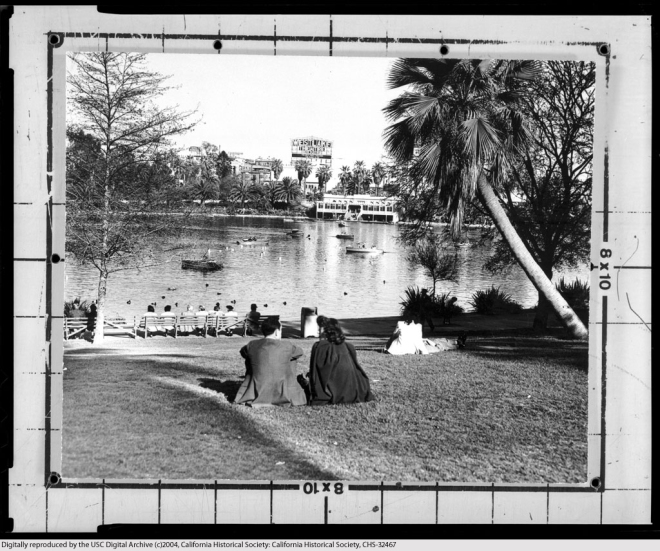
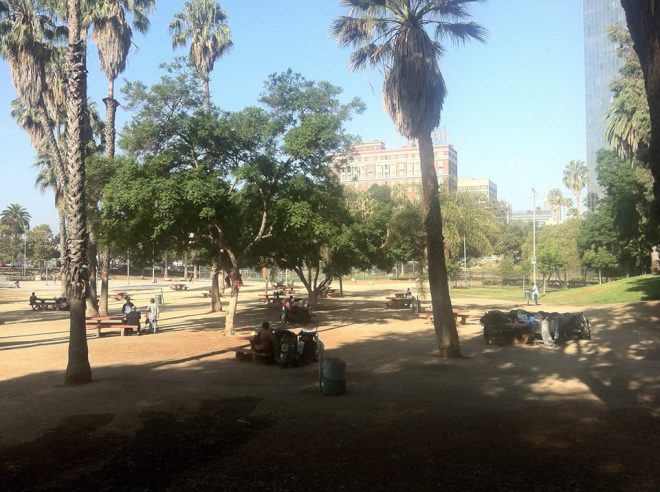
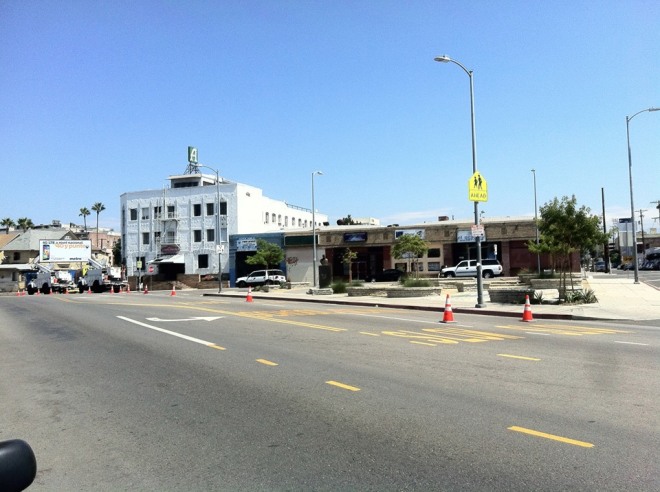


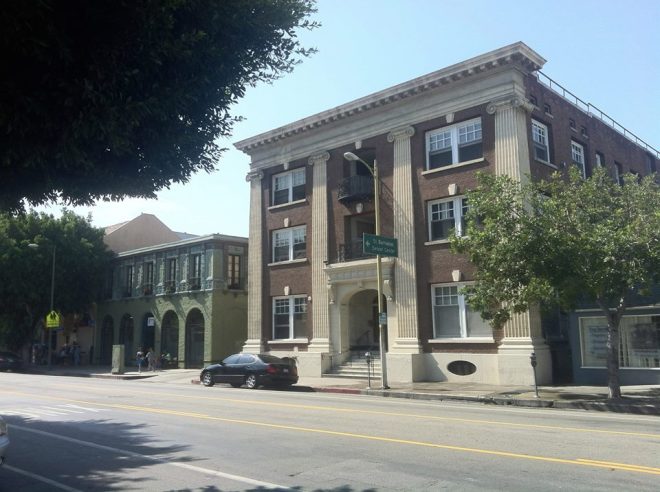
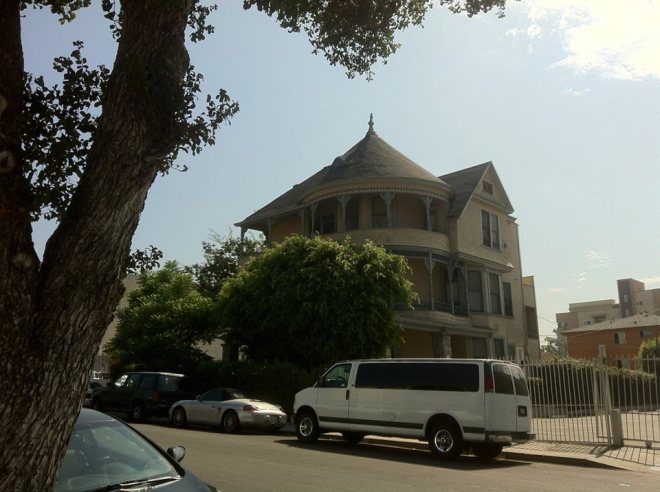


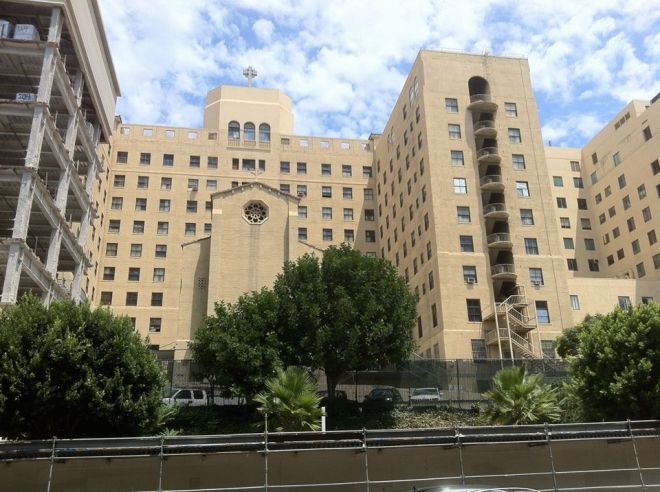




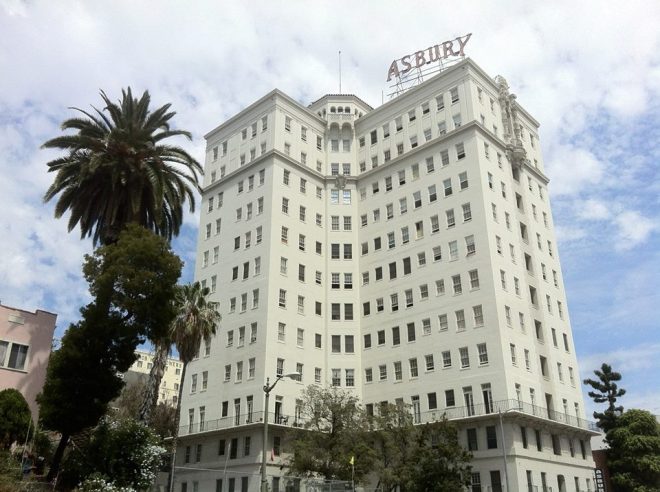




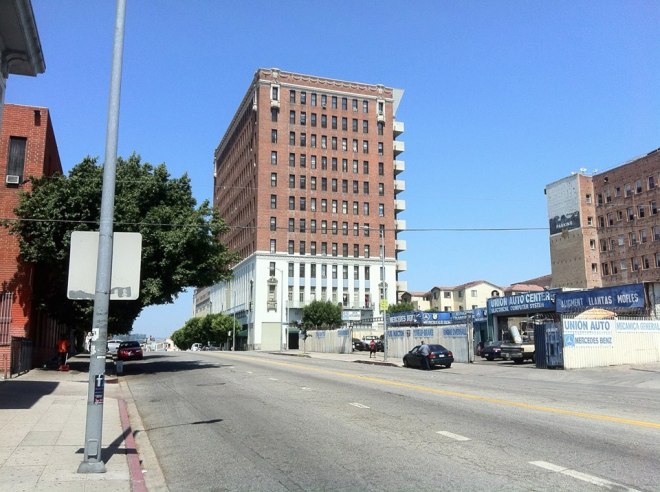




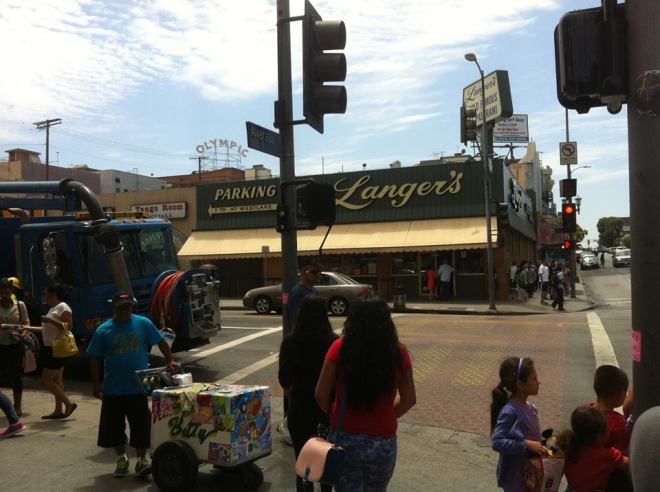







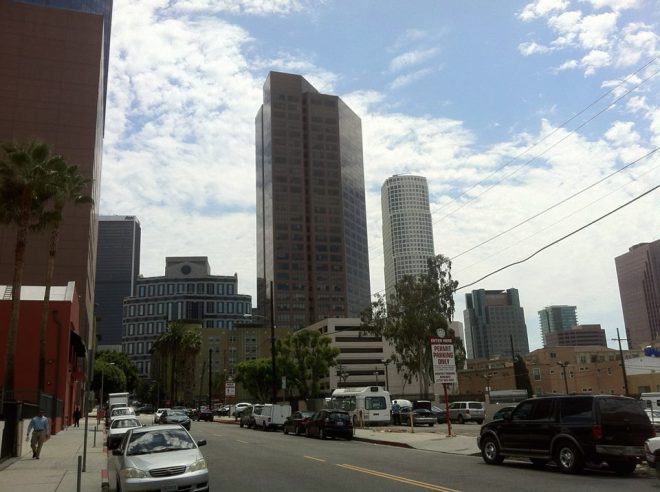





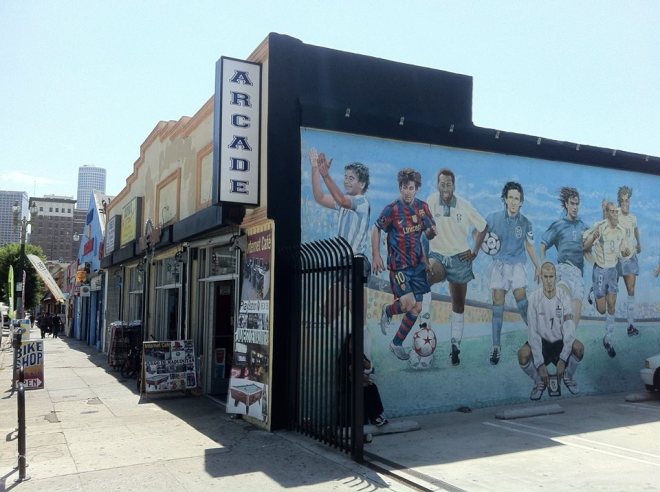





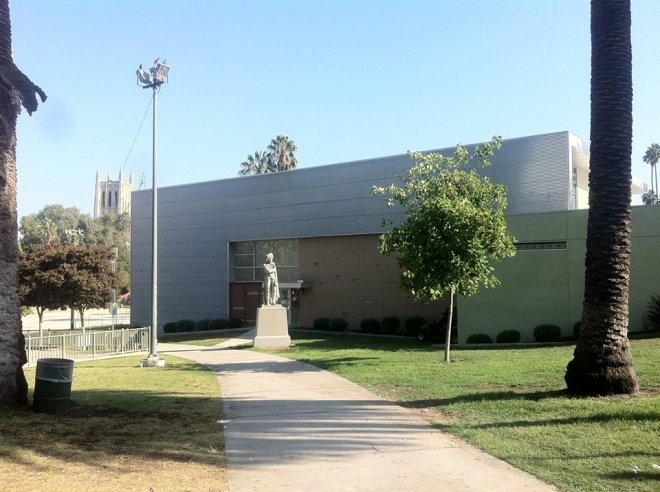



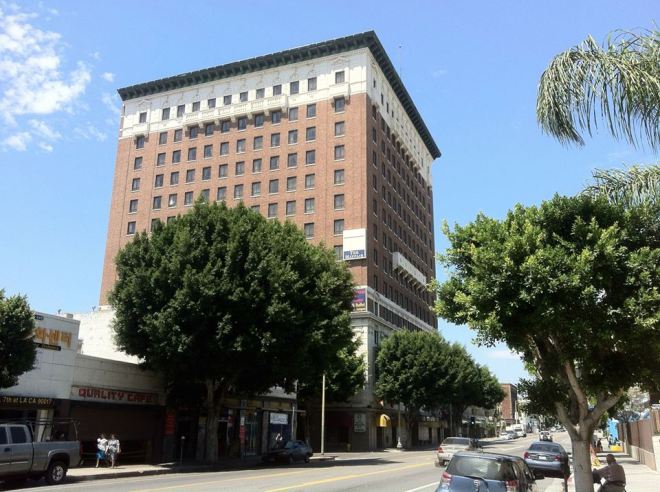

No comments:
Post a Comment